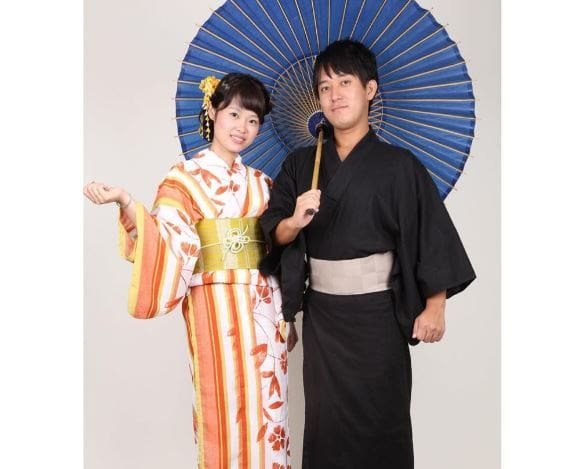INTRODUCTION
Textiles have long played an important role in Japanese life. Japanese weavers and dyers used silk, hemp, ramie, cotton and other fibers, and a range of weaves and decorative treatments, to produce textiles of distinctive design and exceptional aesthetic merit. These textiles were put to many different uses: for clothing of both commoners and elites; for banners, hangings, and other materials produced for use in temples; for theatrical costumes; and for cushion covers, curtains, and other domestic uses. As with many other Japanese arts, Japanese textiles historically have developed through an interaction of external influences and indigenous techniques and design choices, and a tendency to develop both technology and aesthetics to a high degree of refinement
HISTORICAL OVERVIEW
The explosive growth in the number, wealth, and power of Buddhist temples in the Nara Period (710-785) led to an intensified development of textile arts, as well as the importation of mainland textiles on a massive scale. The ensuing Heian Period (795-1185) saw a greater emphasis on domestic production, partly in imperial workshops and partly in private ones. This period saw the continued importance of brocade and embroidery, along with increased use of pattern-woven cloth as a ground for patterned dyeing, whether done by wax- or paste-resist methods or various techniques of shaped-resist dyeing. As the harmonious use of colors in multiple layers of clothing was one of the chief aesthetic principles of dress in this era, great efforts were made to expand and perfect dyeing methods.
The Kamakura (1185-1233) and Muromachi (1338- 1477) periods saw the establishment of military rule under the auspices of the samurai (warrior) class. International trade increased again during this period, bringing a wealth of new materials, techniques and design motifs to Japan. Cotton was introduced at this time, largely supplanting the use of hemp fiber in textiles used by commoners. The development of the Nôh theater under the patronage of the military aristocracy during the Muromachi Period, with its attendant demand for luxurious and brilliantly beautiful costumes, stimulated textile production and innovation. The introduction of multi-harness looms and improved drawlooms led to an increase in production of complex silk fabrics such as damask and satin, which often were used as background fabrics for patterned dyeing (damask) and for embroidery (satin).
JAPANESE SHIBORI DYEING
Shibori is considered to be one of the oldest indigo dye techniques in Japan. Originating in China, shibori dyeing really gained mainstream traction in Japan during the Edo Period from the 17th-19th centuries, as people from the lower social classes needed an alternative to the silk that they were banned from wearing. Although that that doesn’t sound too old (relatively speaking!) in reality, shibori’s origins go way beyond the 1600s.
The earliest examples of shibori textiles date all the way back to the 8th century. It was during that time that Emperor Shomu included a piece of shibori dyed cloth in a collection of items donated to Nara’s Todai-ji Temple. As time progressed, new variations of the technique came into being, and additional dye techniques like tsutsugaki, the art of creating patterns using rice paste before dying, began to follow suit.
What’s the Difference Between Shibori and Regular Tie-Dye?

Cotton Shibori Jacket, Early 20th Century, The Museum of Fine Arts, Boston
Shibori artists use thread to isolate many small repeated points on the fabric; after dyeing this spots of color create captivating designs, that tend to be far more intricate and detailed than modern tie-dye.
The tie-dye we know from the 1960s generally uses one more straightforward technique of twisting and tying the middle of the shirt to create a psychedelic spiral design. Finally, while tie-dye tends to draw from the entire rainbow color spectrum, more often than not the shibori dye is only one color.
What are the Different Types of Shibori Techniques?

Bong Grit / Creative Commons, Shibori Fabrics
There are several different branches of the shibori family tree, each with a different technique, design style and aesthetic. You could say that western tie-die is also a distant relation, but taking a more traditional view, there are six standard shibori techniques.

Shibori Happi Coat, Late 19th Century, The Museum of Fine Arts, Boston
Kumo Shibori is the most conceptual technique. The process uses miscellaneous found objects to create the patterns. Shibori designers tie fabric around these items which are used as the resist and the outcome is as unique as the objects selected
Miura Shibori uses the processes of looping and binding to create patterns. A slightly more involved process, miura designers need to pluck pieces of the cloth with a hook and needle. The outcome is more intricate repeated deisgns.
Kanoko Shibori is the style that most closely resembles tie-dye. Like their western counterparts, kanoko practitioners today often use elastic bands to tie the fabric, as opposed to the threads of fabric they would have used in the past.

Arashi Shibori is another take entirely. Also referred to colloquially as pole wrapping shibori, the process uses, as you may have guessed, wooden or copper poles to twist, wrap and bind the cloth. The outcome is typically a diagonal style pattern that looks almost like the veins of a leaf.
Nui Shibori is the most detailed of all the shibori techniques and is as much about stitching as it is about dyeing. By using hand stitching techniques and wooden dowels to create resists, the outcome of this process is carefully crafted designs with accurate patterns.
Itajime Shibori is the technique that creates the most robust patterns. Itajime practitioners use wood, and in more contemporary times, plastic and clam resist to craft thick, bold patterns like repeated squares, triangles, circles.
Where to Find Modern Shibori?

© Suzusan, Modern Shibori Fashion
Shibori’s aesthetic qualities are twofold; the use of indigo dye and traditional techniques means that the outcome always feels organic. In addition, the artisanal handcrafted quality of the process means that each piece is still unique. It’s a connection to the ancient, with an outcome that’s always slightly new. With such a balance of qualities, it’s no surprise that modern designers are increasingly avid fans of shibori.
Hailing from Arimatsu, a town in Aichi Prefecture famous for its shibori and tye-die legacy, the Suzusan label is an effort of icons of the scene, the Murase family. The eldest son of the family’s fourth generation, Hiroyuki Murase, is one of shibori’s most progressive figures. He founded Suzusan as a design company in Düsseldorf, combining the family’s legacy with his futuristic ideologies. The Murase family have passed down the shibori legacy through five generations and well over a century, they straddle the line between pushing the boundaries of what shibori can be, while keenly staying to the roots of the art form.
The Suzusan label produces clothing, which is often more modern in style, as well as rustic homewares like cushion covers and throws that shamelessly hark back to the more old-world way of doing things; simple, organic, and beautiful. Their most attention commanding output, however, has to be Hiroyuki’s innovative combination of shibori with lighting and accessories, the project is called Suzusan Luminaires.

© Yuh Okano Scarf
New York City-based artist Yuh Okano rose to international attention during the late 1990s when her uncanny ability to craft unique pieces of shibori dyed fabric caught the eyes of influential figures like Donna Karan and Martha Stewart. Today, she works predominantly with silk scarves, combining this ancient art form with a contemporary influence, flirting with color and avant-garde patterns. You can find her work throughout Japan and the US and on her online store.
In a recent interview New York-based designer Oriana DiNella explained her appreciation for shibori: “The stillness and beauty of it really centers me… It feels like a rebellion against the fashion movement, where everything seems so fast and disposable.” This message of anti-fast fashion and carefully created designs were the motivations DiNella’s new online line of shibori homeware.
JAPANESE SEWING AND WEAVING TECHNIQUES
Recycling of cotton textiles has a long history in Japan, going back at least to the early 1600s. In the Northern Japanese islands industrious Japanese women worked with used cotton indigo dyed fabrics to perfect several sewing techniques in order to give renewed life to the secondhand cloth. They created new uses for these discarded materials by layering several pieces of cloth, attaching each together with sashiko stitching and then, if needed, boro patching them. Subsequently, these patchwork textiles could then be reassembled into warm clothing, futon covers and other common household items for the family’s use. The resulting soft cotton textiles were a welcome relief from the harsh textured hemp fabrics native to the region.
- Sashiko
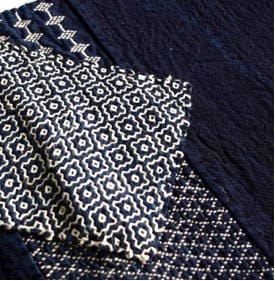 Sashiko is a traditional form of Japanese hand sewing that uses a simple running stitch sewn in repeating or interlocking patterns, usually piercing through several layers of fabric. From the 17th century onward, creative rural Japanese seamstresses discovered an important feature of sashiko stitching. If the layers of fabric were held together with sashiko stitching, home made hemp and cotton clothing provided much better protection from the elements, lasted longer and even added a creative and individual flare to their handmade garments. As a result, sashiko grew into a widely favored sewing technique and quickly became established throughout Japan for use as a utilitarian and dramatic embroidery.
Sashiko is a traditional form of Japanese hand sewing that uses a simple running stitch sewn in repeating or interlocking patterns, usually piercing through several layers of fabric. From the 17th century onward, creative rural Japanese seamstresses discovered an important feature of sashiko stitching. If the layers of fabric were held together with sashiko stitching, home made hemp and cotton clothing provided much better protection from the elements, lasted longer and even added a creative and individual flare to their handmade garments. As a result, sashiko grew into a widely favored sewing technique and quickly became established throughout Japan for use as a utilitarian and dramatic embroidery.
Thrifty Japanese farm women also employed the sashiko stitch to boro repair common household items like futon covers, garments and pillows. Sashiko stitching is commonly found on boro futon covers, noragi clothing (jackets and vests), aprons, zokin dusting cloths and other Japanese folk textiles. Sashiko thread colors range from white to a deep blue-black. White sashiko thread was used most often with contrasting indigo-dyed cotton fabric.
Kogin sashiko, as seen in the photo here , is the extreme esthetic example of sashiko usually employing white thread stitching over solid indigo fabric for the design.
Sashiko clothing was worn by all members of the lower working classes of Japanese society and carried with it a inferior social status of the communities from which it originated. As a result, sashiko never became fashionable among the middle and upper classes but remained firmly culturally linked to poverty-stricken rural regions.
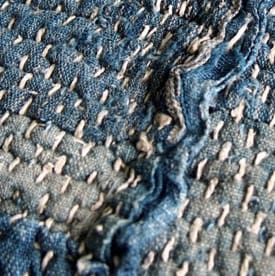
Country women had few choices of fabrics for use when it came to tailoring their working garments. They might use either (1) locally produced, labor intensive, woven bast fiber materials (asa, mainly hemp) or (2) remnants of discarded cotton fabric that seafaring traders carried northward from the warmer cotton producing areas of Western Japan.
Once large quantities of scrap cotton regularly began arriving in Northern Japan, it quickly became the fabric of choice among rural women because it was easier to work with, softer, warmer and generally more versatile than locally grown bast fiber materials. Soft cotton was favored for clothing because it was considered a luxurious fabric as compared to rough and prickly hemp.
Heavy winter-weight fabrics were constructed from cotton remnant fabrics that were attached to each other with sashiko stitching in patchwork styled layers; the more layers, the warmer and stronger the fabric (as seen in the photo above.). Subsequently, rural wives used these newly made larger pieces of sashiko fabrics to fashion cold weather utilitarian working garments for their farmer and fisherman husbands as well as other family members.
Zanshi Weaving( zanshi orimono)
Zanshi is a Japanese word which means “vestige,” or “leftover”. Zanshi textiles were woven from the extra threads which remained after looming fixed pattern weaving. These limited quantities of leftover zanshi threads were unable to be utilized, because there were not enough of them to make another weaving of the same pattern. Thus, these vestige threads were used to weave wonderful one-of-a-kind mixed threads Japanese Zanshi folk textiles. At the time they were made, these zanshi folk textiles were regarded as seconds, or items that were not up to standard quality.
Zanshi weaving is often recognized and characterized by slubs (lumps or thick places in the yarn or thread), uneven looming, and random color threads woven together to create a unique textile. At rural textile cooperatives, home spun threads were hand loomed into casual zanshi designs. These designs provide today’s collector with an excellent illustration of the depth and variety of Japanese folk textiles.
Sakiori Weaving
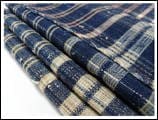
Zanshi is a Japanese word which means “vestige,” or “leftover”. Zanshi textiles were woven from the extra threads which remained after looming fixed pattern weaving. These limited quantities of leftover zanshi threads were unable to be utilized, because there were not enough of them to make another weaving of the same pattern. Thus, these vestige threads were used to weave wonderful one-of-a-kind mixed threads Japanese Zanshi folk textiles. At the time they were made, these zanshi folk textiles were regarded as seconds, or items that were not up to standard quality.
Zanshi weaving is often recognized and characterized by slubs (lumps or thick places in the yarn or thread), uneven looming, and random color threads woven together to create a unique textile. At rural textile cooperatives, home spun threads were hand loomed into casual zanshi designs. These designs provide today’s collector with an excellent illustration of the depth and variety of Japanese folk textiles.
Sakiori Weaving
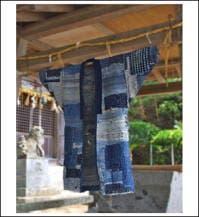
Beginning in the 18th century, Japanese farm women, during seasonal cold periods in Northern Japan, used a home loom to weave scraps of old fabrics into sakiori textiles. These hardy women would turn their woven lengths of rather narrow sakiori weavings (5 ~ 14 inches wide) into utilitarian household textiles like rugs, kotatsu (heated table) covers and practical garments like warm work jackets, vests and informal kimono obi. Although indigo was the most common color, often these domestically made sakiori textiles, especially the obi and rugs, included very colorful designs because of mixing into the weave random varieties of old brightly dyed fabrics that had been specifically set aside for making sakiori.
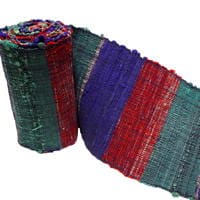
The Japanese word sakiori comes from “saki,” which means to tear or rip up, and “ori,” which means weave. “Saki” relates to preparing the fabric by striping it into pieces and “ori” refers to weaving it together. The process is similar to American rag weaving but different in a single respect: rag weave uses only fabric to loom the woven textile whereas the Japanese sakiori method weaves together pieces of cotton cloth for the weft and cotton yarn for the warp. With sakiori, the torn cloth pieces are rolled into 13 to 16 inch lengths and loomed together in weft (width) rows and using cotton or hemp (rare) as the warp yarn. (length).
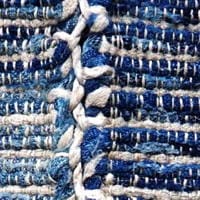
Farmer’s Clothing jackets & Vests (Noragi)
Japanese farm women spun and loomed cotton fabric so that they could make clothing for their family. Fabric that they did not use at home was often sold for supplemental income. This homemade, hand-stitched rural work clothing is called noragi in Japanese. Jackets, vests and monpe pants were the three most common noragi garments. The noragi tradition was passed down from each generation to the next, from mother to daughter, and became part of the basic homemaking repertoire of every Japanese farm woman. These women not only made clothing but also created other household items from the cotton fabric: futon (mattress) covers, curtains, furniture covers, aprons, and other workaday articles. Indigo was the primary textile color. Kasuri, katazome and shibori patterns were popular and were often incorporated into the fabrics’ design. These patterns enriched the fabrics, evoking a feeling of joy and sometimes mythical significance, thereby helping to alleviate the routine drudgery of farm life. The vintage/antique farm clothing we catalog and sell on this site were actually used by Japanese farm women, who wore the garments while working in the house or in the fields. In addition to their household workload, Japanese women spent as much time laboring in the fields as their men. Their clothing might have been made from scraps or new fabric, or a combination of the two.
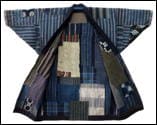
Uniquely Japanese,Boro Futon Covers.
Boro is a Japanese word meaning “tattered rags” and it’s the term frequently used to describe lovingly patched and repaired cotton bedding and clothing, used much longer than the normal expected life cycle. Like early North American patchwork quilts, boro textiles revealed much about the Japanese family’s living standards and the nature of the economy of their time.
The penny-wise Japanese rural wife repaired the family’s sleeping futon covers again and again by “boro” patching fabric scraps over thin areas and holes in the fabric. Adding sashiko sewing to the repair gave greater strength to the material.
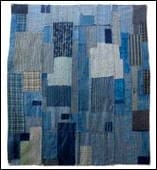
The same sewing technique that was used to repair boro futon covers was also put into practice when repairing noragi (farm clothing). This was done in order to increase the lifespan of the clothing and add extra layers of fabric thickness for warmth.
At the time when Japan was struggling to recover from the devastation of the Second World War, the Japanese regarded boro textiles with great shame in that these utilitarian textiles served as an open reminder of Japan’s impoverished past. Today both Japanese and international collectors regard boro textiles as striking examples of a bygone and lost folk craft. These same textiles are cherished and collected for the stories they tell and the windows they open into Japanese folk culture and history.
JAPANESE TRADITIONAL DRESS

The kimono is japanese traditional dress literally `the thing worn’, is the classic garment for both men and women. Traditionally, kimonos were worn layer upon layer. The number of layers related to the importance of the wearer; in the most extreme cases so many would be worn that the wearer could scarcely move. In reality, most women’s kimonos are more intricate in structure than just described, having additional material on each side of the front opening and an extra neckband. Outer kimonos for formal wear often have an interlining and a lining. Traditionally, this lining was orangey-red in colour and curved up around the hemline so that it was visible on the outside. All kimonos are fastened with a sash called an obi which fits comfortably round the waist and under the hanging sleeves. The sleeves are not completely joined to the body at the armholes for this purpose.
FABRIC OF KIMONO

Fabric to make up a Japanese traditional dress like kimono is purchased in a set length called a tan. This is about 11.7m long and about 34cm wide and is enough for one garment. Two long pieces are cut from this to make up the front and back left and the front and back right respectively. A vertical seam at the centre back joins the two sections, and further lengths are folded over and seamed to the body to form sleeves. Sleeve depths vary from garment to garment. Many early 20th-century kimono are made from meisen, a fabric woven from silk obtained from defective cocoons. The introduction of mechanised spinning technology meant it was possible to use this lower-quality silk to create a thick, lustrous material that was both long-lasting and relatively inexpensive. Patterned with chemical dyes using an innovative direct-dyeing technique, meisen became the fabric of choice for women’s fashionable, casual kimono.
YUKATA

A popular japanese traditional dress which is usually made of cotton or synthetic fabric is known as Yukata. This is also worn by both men and women in summer as a light and casual garment. Compared with other types of kimonos, Yutaka kimonos are much easier to wear and maintain and are less expensive. Traditionally, yukata were mostly made of indigo-dyed cotton, but today, a wide variety of colors and designs are available. Yukata are also worn at Japanese inns ryokan.
HAPPI

Happi is the japanese traditional dress which is worn by male performers, particularly in dances, which is actually a straight sleeved jacket. Happi is normally having an open front and it is fastened with ties. In the modern patterns, Happi are worn over clothes and tied at the waist with a belt. In the festivals, Japanese men wear Happi adorned with spectacular icons and glorious patterns. Hachimaki is the traditional Japanese headbands which are worn in order to keep the wearer safe from evil spirits. Hachimaki are usually made from a strip of white or red cloth approximately 8 centimeters in length. They may be worn flat against the forehead or rolled into a cylindrical shape.
TOURISM

Japan attracted 31.19 million international tourists in 2018 Japan has 21 World Heritage Sites, including Himeji Castle, Historic Monuments of Ancient Kyoto and Nara. Popular foreigner attractions include Tokyo and Hiroshima, Mount Fuji, ski resorts such as Niseko in Hokkaido, Okinawa, riding the shinkansen and taking advantage of Japan’s hotel and hotspring network.
The 2017 Travel and Tourism Competitiveness Report ranked Japan 4th out of 141 countries overall, which was the highest in Asia. Japan gained relatively high scores in almost all of the featured aspects, such as health and hygiene, safety and security, and cultural resources and business travel.
Official website: https://www.japan.travel/en/

